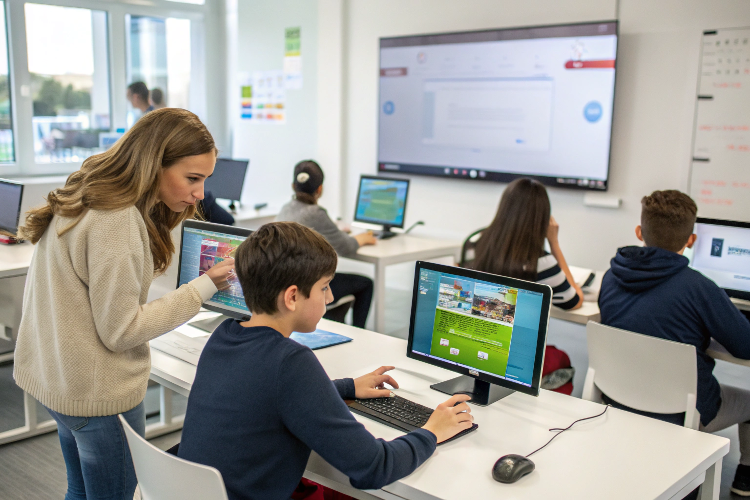Blog
How Gamification is Enhancing Student Engagement in E-Learning ?
EdTech & Online Learning ▪ 2025-03-13

The rise of e-learning has transformed education, making knowledge more accessible than ever. However, student engagement remains a major challenge in online learning environments. Without face-to-face interactions and classroom motivation, learners often struggle with distraction, boredom, and lack of motivation.
To solve this issue, educators and e-learning platforms are turning to gamification—the application of game elements like points, badges, leaderboards, and challenges to boost motivation and participation. Gamification makes learning more interactive, engaging, and fun, helping students stay focused and improve retention.
This blog explores how gamification is enhancing student engagement in e-learning, its key benefits, real-world examples, and best practices for implementing it effectively.
1️⃣ What is Gamification in E-Learning? Understanding the Concept
🚀 Gamification involves integrating game mechanics into non-gaming environments to drive motivation and engagement.
✔ In e-learning, gamification enhances student interaction, competition, and achievement-driven learning.
✅ Key Gamification Elements in Online Learning:
✔ Points & Rewards – Learners earn points for completing tasks or quizzes.
✔ Badges & Achievements – Digital awards for progress and accomplishments.
✔ Leaderboards – Rankings to encourage healthy competition.
✔ Quests & Challenges – Interactive tasks that simulate real-world scenarios.
✔ Instant Feedback – Immediate rewards and corrections to reinforce learning.
💡 Example: Duolingo uses gamification by awarding XP points, badges, and streaks to motivate language learners.
🔗 Pro Tip: Gamification taps into students’ natural desire for achievement, making learning more interactive and rewarding.
2️⃣ The Science Behind Gamification: Why It Works
✔ Gamification is effective because it leverages psychological principles of motivation and engagement.
✔ It stimulates the dopamine system, which enhances focus, learning, and memory retention.
✅ How Gamification Improves Learning Based on Psychology:
✔ Intrinsic Motivation (Self-Determination Theory) – Encourages students to learn for personal growth and satisfaction.
✔ Instant Gratification & Feedback Loop – Rewards and progress tracking create a sense of accomplishment.
✔ Active Learning & Participation – Interactive challenges keep students engaged longer.
✔ Social Learning & Competition – Leaderboards and peer comparisons boost engagement.
💡 Example: A study by the University of Colorado found that gamified e-learning improved knowledge retention by 40%.
🔗 Pro Tip: Gamification turns passive learning into an engaging, active experience that keeps students invested in their education.
3️⃣ The Benefits of Gamification in E-Learning
✔ Gamification is more than just fun—it enhances engagement, improves retention, and encourages learning persistence.
✅ Key Benefits of Gamification in Online Learning:
✔ Increases Student Engagement – Keeps learners motivated through interactive elements.
✔ Enhances Retention & Knowledge Application – Game-based learning reinforces concepts.
✔ Encourages Healthy Competition – Leaderboards boost motivation and peer learning.
✔ Makes Learning Enjoyable & Interactive – Breaks the monotony of passive learning.
✔ Provides Instant Feedback & Progress Tracking – Helps students stay on course.
✔ Promotes Self-Paced Learning – Students can progress at their own speed.
💡 Example: Khan Academy uses gamified elements like mastery points and progress tracking to encourage continuous learning.
🔗 Pro Tip: Gamification transforms learning from a chore into an engaging challenge, increasing student persistence.
4️⃣ How Gamification is Applied in Different E-Learning Environments
✔ Gamification is used across various educational fields, from K-12 education to corporate training and professional skill development.
✅ Gamification in Different Learning Environments:
✔ 🎓 K-12 & Higher Education – Encourages active participation in online classrooms.
✔ 💼 Corporate Training & Employee Development – Enhances skill-building and knowledge retention.
✔ 📚 Language Learning Platforms – Gamifies vocabulary building (e.g., Duolingo, Babbel).
✔ 🏥 Medical & Healthcare Training – Uses simulations to teach complex medical concepts.
✔ 🎯 Technical & IT Certifications – Creates interactive coding challenges and quizzes.
💡 Example: Google’s "Grasshopper" app teaches coding through gamified lessons and interactive challenges.
🔗 Pro Tip: Gamification works in various learning settings by making complex subjects easier to digest.
5️⃣ Best Practices for Implementing Gamification in E-Learning
✔ To make gamification effective, it must be well-designed, meaningful, and aligned with learning objectives.
✅ How to Design Engaging Gamified E-Learning Content:
✔ Align Game Mechanics with Educational Goals – Ensure that badges, points, and rewards reinforce learning.
✔ Make Progress Visible – Allow students to track achievements and unlock new levels.
✔ Use Adaptive Challenges – Provide personalized experiences based on learners’ performance.
✔ Encourage Social Learning – Introduce peer-based leaderboards and team challenges.
✔ Keep it Simple & Engaging – Avoid overcomplicating game elements, as simplicity enhances effectiveness.
💡 Example: Edmodo’s gamification system includes badges for student achievements, making classroom participation more exciting.
🔗 Pro Tip: Gamification should enhance learning—not distract from it. Keep elements simple, relevant, and motivating.
6️⃣ The Future of Gamification in E-Learning
✔ The next evolution of gamification will integrate AI, VR/AR, and adaptive learning technologies to create personalized and immersive learning experiences.
✅ Upcoming Trends in Gamified E-Learning:
✔ AI-Powered Gamification – AI-driven learning paths based on student behavior.
✔ Virtual Reality (VR) & Augmented Reality (AR) Learning – Immersive game-based training experiences.
✔ Gamified Learning Apps – AI-driven mobile learning apps for self-paced education.
✔ Blockchain-Based Credentialing – Digital badges that verify real-world skills.
💡 Example: Medical schools are using VR-based gamification to train future doctors in realistic simulations.
🔗 Pro Tip: Emerging technologies like AI and VR will further enhance gamified learning experiences.
Gamification is revolutionizing education, making online learning more engaging, interactive, and effective. Whether for K-12 students, college learners, or corporate professionals, gamified e-learning keeps users motivated, improves retention, and enhances knowledge application.
Key Takeaways:
✅ Gamification boosts student engagement, making learning fun and interactive.
✅ It enhances retention, motivation, and participation through game-based mechanics.
✅ E-learning platforms use gamification in various industries, from education to corporate training.
✅ Future trends include AI, VR/AR, and personalized adaptive gamification models.

